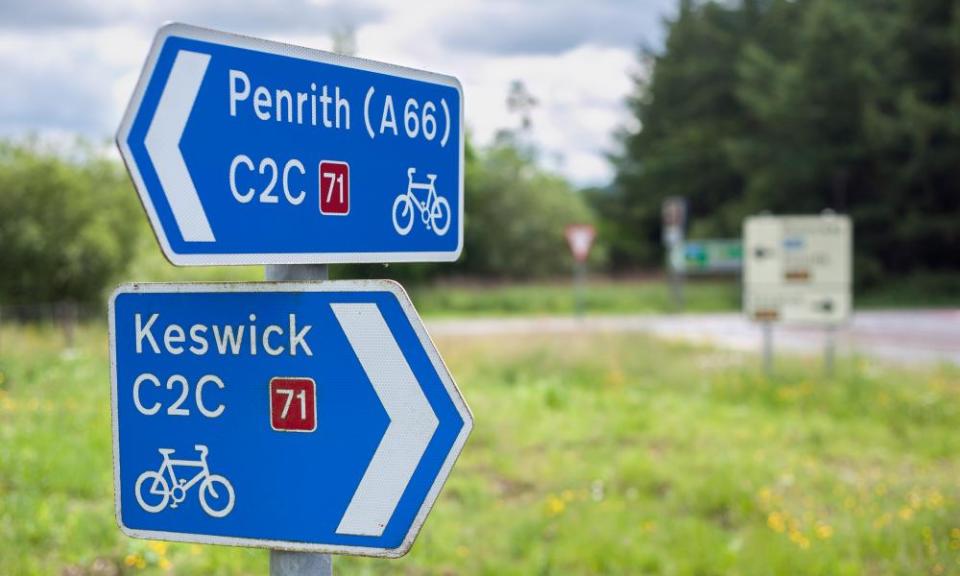National Cycle Network cuts a quarter of its routes on safety grounds

The National Cycle Network (NCN) will lose almost a quarter of its 16,000 miles of UK-wide cycling and walking routes from Monday, as part of an ongoing plan to improve safety standards. Some of the UK’s favourite long-distance cycle routes, including the Coast to Coast (C2C) from Whitehaven to Tynemouth, will now no longer be part of the official network because it has a fast 4.5-mile on-road stretch over the Hartside Pass in Cumbria.
The move follows a 2018 review by Sustrans, the charity that created the NCN, which found that 42% of the network’s routes were “poor”, with substandard crossings, signage or main road sections, and 4% “very poor”, taking cyclists on roads with heavy traffic. In addition, urban roads with speed limits in excess of 20mph and rural roads faster than 40mph are being taken out of the network.
Almost 19% of the network will now be designated for experienced cyclists only, and 4.5% (753 miles) of busy on-road sections will have all signage removed.
Sustrans chief executive officer, Xavier Brice, said the review forms part of a strategy called Paths for Everyone, and what will remain is a mostly low-traffic or traffic-free network that is well-surfaced, clearly signed and accessible to all who cycle and walk. He said that a “rush for miles” over the years had damaged the image of the cycling charity and the NCN. “This isn’t about experienced cyclists; this is about it being for everyone. It’s about making sure people can trust the network.”
The NCN was started when volunteers dug out the Bristol to Bath Railway path in June 1979. In the intervening years, off- and on-road sections have been added, and some of those roads have become a lot busier, and faster. For many, these changes are long overdue. John Grimshaw, who designed and helped dig the pioneering Bristol to Bath Railway path, said: “We always defined the network as traffic-free and with roads seeing up to only 1,000 vehicles a day. The thing that matters about routes is continuity, that you start a route and you know you’ll be able to finish it.”
However, at a time when the Covid-19 pandemic has served to boost the popularity of cycling and holidaying at home, there will be concerns over the loss of branding and signage for significant parts of the network: cycling holidaymakers spend £520m a year in the UK, according to a Cycling UK report on the benefits of cycle tourism. .
Adam Walker, of cycle holiday firm Saddle Skedaddle, said that enquiries are pouring in from people who took up cycling on quiet roads during the lockdown. “The NCN provides a lot of business for lots of different people all along the routes: holiday companies, accommodation, restaurants, cafes and pubs.”
Walker believes that while reclassification is unlikely to harm iconic, quality routes such as the popular C2C path, it may well act as a spur for landowners to improve sections that are deemed substandard, by funding protected cycleways or adjacent quiet routes. Sustrans has funded 55 “activation projects”, in conjunction with landowners, to improve missing links, nine of which are now complete – and it says more improvements are planned.
Sustrans owns just 348 miles of the NCN and is responsible for 80% of that land’s upkeep. While it is contracted to maintain routes for some local authorities, on other routes the charity relies on volunteers and donations for upkeep. The charity estimates it will cost £2.8bn to bring the network up to standard. In 2018 its 3,500 volunteers contributed 250,000 hours a year to the charity – an average of 5.8 hours per volunteer per month.
Elsewhere under the review plans, 80% of Northern Ireland’s network will be reclassified, and around a third of the Scottish NCN, including the Caledonia Way – a jewel in the crown of the network – due to a significant fast and narrow on-road section adjacent to Loch Ness. Other famous routes that will be reclassified include the entirety of the Hebridean Cycleway; the final 122-odd miles of the iconic Land’s End to John O’Groats route (NCN1); and everything northward to the Orkneys. Also out of the network is the route circumnavigating the Isle of Wight, which will be a blow for an island that prizes its cycle routes.
Brice said the changes aren’t being made lightly: “We aren’t cutting these sections loose, and we realise how important they are to the local economies and people who use them. I just think we need to be more careful than we have been in the past.” This, he said, is part of the long-term vision of Paths for Everyone.

 Yahoo Sport
Yahoo Sport 





































